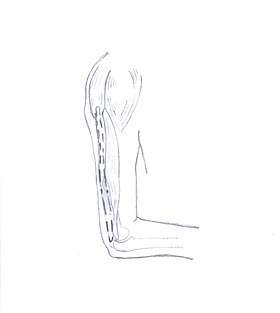Tendon transfer
A tendon transfer is a surgical process in which the insertion of a tendon is moved, but the origin remains in the same location. Tendon transfer involves redistribution of muscle power, not recreation. Tendons are transferred at the distal attachment from lesser to more important functions so that the overall function is improved. Tendon transfers provide a substitute which can be permanent or temporary, when muscle function is lost either due to nerve injuries or injuries to the muscle/tendon unit. Tendon transfers are also performed to correct the imbalanced muscle tone due to spasticity resulting from injuries to the central nervous system.
| Tendon transfer | |
|---|---|
 Posterior deltoid-to-triceps tendon transfer to restore elbow extension | |
| ICD-10-PCS | 0LX |
| ICD-9-CM | 82.56, 83.75 |
| MeSH | D013709 |
Principles
Preoperative evaluation of the patient is required to map out functional deficits, and determine which muscles are available for transfer. Time from injury, type of injury, and success of previous treatment should also be taken into account. Electrodiagnostic studies may be useful in determining the extent of motor loss and predicting the muscle recovery. It may also be useful to detect abnormal nerve pattern such as median-to-ulnar nerve anastomosis, which may influence the choice of transfer.
The donor muscle must have enough strength (work capacity) to duplicate the recipient function. The work capacity depends upon muscle fibre's length and cross sectional area, which are proportional to muscle mass and volume. In other words, a larger muscle produces more force and a longer muscle has a greater excursion. There are potential factors that may result in loss of muscle strength including postoperative adhesion, difference in vector of motion.[1]
The donor tendon must also be expendable. In other words, it must not result in functional deficit after transfer. The remaining muscles must have enough level of strength to account for the loss of the original function of the donor muscle. Transfers can generally be classified into either power or positional transfers. Power transfers are done to perform motion, and therefore requires relatively more powerful donor muscles. Positional transfers, on the other hand, do not require powerful donors. The strength of the antagonist muscle should be similar to the donor to avoid overcorrection and to maintain correct posture.[2] Tendon excursion, or distance a tendon travels upon movement, should be similar to that of the recipient to adequately restore the function.
Any transfer of a tendon for another function will generally lose one grade of power. For example, M4 muscle power grade will become M3. A single tendon should be used to restore a single function. Transfer of one tendon to restore multiple functions will compromise strength and movement.[3]
Medical uses
These are examples of commonly performed tendon transfers.
| Donor | Recipient | Function |
|---|---|---|
| Protetor teres | Extensor carpi radialis brevis | Wrist extension |
| Palmaris longus | Abductor pollicis longus | Thumb abduction |
| Flexor digitorum superficialis (little finger) | Extensor pollicis longus | Thumb extension |
| Flexor digitorum superficialis (ring finger) | Extensor digitorum | Finger extension |
| Donor | Recipient | Function |
|---|---|---|
| Tibialis posterior | Tibialis anterior | Dorsiflexion of foot |
| Flexor digitorum longus | Extensor digitorum longus and extensor hallucis longus | Digit extension and big toe extension |
History
Many of the lower extremity tendon transfers were performed during the nineteenth century to improve ambulation in polio patients due to post-poliomyelitis paralysis.[6] In the beginning o twentieth century, tendon transfers were used to correct congenital talipes equina.[7] Tendon transfers were extensively performed during World Wars I and II to patients with upper extremity injuries.[8]
References
- Omer, George E. (2004-08-01). "Tendon transfers for traumatic nerve injuries". Journal of the American Society for Surgery of the Hand. 4 (3): 214–226. doi:10.1016/j.jassh.2004.06.012. ISSN 1531-0914.
- Wilbur, Danielle; Hammert, Warren C. (2016-05-02). "Principles of Tendon Transfer". Hand Clinics. 32 (3): 283–289. doi:10.1016/j.hcl.2016.03.001. ISSN 1558-1969. PMID 27387072.
- Scuderi, C. (May 1949). "Tendon transplants for irreparable radial nerve paralysis". Surgery, Gynecology & Obstetrics. 88 (5): 643–651. ISSN 0039-6087. PMID 18120520.
- Beasley, R. W. (November 1970). "Tendon transfers for radial nerve palsy". The Orthopedic Clinics of North America. 1 (2): 439–445. ISSN 0030-5898. PMID 5521865.
- Vigasio, Adolfo; Marcoccio, Ignazio; Patelli, Alberto; Mattiuzzo, Valerio; Prestini, Greta (June 2008). "New Tendon Transfer for Correction of Drop-foot in Common Peroneal Nerve Palsy". Clinical Orthopaedics and Related Research. 466 (6): 1454–1466. doi:10.1007/s11999-008-0249-9. PMC 2384039. PMID 18414961.
- Sammer, Douglas M.; Chung, Kevin C. (2009-05-29). "Tendon Transfers Part I: Principles of Transfer and Transfers for Radial Nerve Palsy". Plastic and Reconstructive Surgery. 123 (5): 169e–177e. doi:10.1097/PRS.0b013e3181a20526. PMC 4414253. PMID 19407608.
- Jeng, Clifford; Myerson, Mark (June 2004). "The uses of tendon transfers to correct paralytic deformity of the foot and ankle". Foot and Ankle Clinics. 9 (2): 319–337. doi:10.1016/j.fcl.2004.03.003. ISSN 1083-7515. PMID 15165586.
- Green, David P. (1999). Green's Operative Hand Surgery. Churchill Livingstone. ISBN 9780443079559.